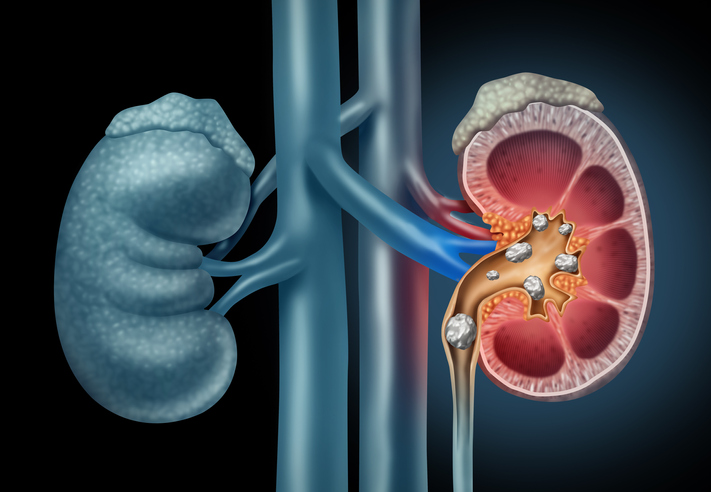Kidney stones are hard collections of salt and minerals often made up of calcium or uric acid. They form inside the kidney and can travel to other parts of the urinary tract.
Stones vary in size. Some are as small as the period at the end of this sentence — a fraction of an inch. Others can grow to a few inches across. Some kidney stones can become so large they take up the entire kidney.
A kidney stone forms when too much certain minerals in your body accumulate in your urine. When you aren’t well-hydrated, your urine becomes more concentrated with higher levels of certain minerals. When mineral levels are higher, it’s more likely that a kidney stone will form.
Signs and symptoms
- Pain from a kidney. A stone that is stuck in a kidney may cause pain in the side of your abdomen (loin). This pain can be very severe and cause you to feel sweaty and be sick (vomit).
- Renal colic: This is a severe pain that is caused by a stone that passes into the tube (the ureter) draining urine from the kidney. The stone becomes stuck. The ureter squeezes the stone towards the bladder, which causes intense pain in the side of your tummy (abdomen).
- Blood in your urine.
- Urine infection.
When to see a doctor?
Make an appointment with your doctor if you have any signs and symptoms that worry you.
- Seek immediate medical attention if you experience:
- Difficulty passing urine
- Pain so severe that you can't sit still or find a comfortable position
- Pain accompanied by nausea and vomiting
- Pain accompanied by fever and chills
- Blood in your urine
گردوں کی پتھری:
گردے ک پتھر نمک اور معدنیات کا سخت مجموعہ ہیں جو اکثر یورک ایسڈ اور کیلشیئم سے بنتے ہیں۔ یہ گردے کے اندر بنتے ہیں اور پیشاب کے نظام کے مختلف اعضاء میں سفر کر سکتے ہیں۔
پتھروں کا سائز مختلف ہوتا ہے۔ کچھ تو اس جملے کے اختتام پر موجود خاتمے جیتنے ہوتے ہیں اور دوسرے پتھر کچھ انچ تک بڑھ جاتے ہیں۔ گردے کے کچھ پتھر اتنے بڑے ہوجاتے ہیں کے وہ پورے گردے میں پھیل جاتے ہیں۔
آپکے پیشاب میں جب بہت زیادہ معدنیات ہوجائیں تو گردوں میں پتھر بن جاتے ہیں۔ اگر آپ کے جسم میں پانی کی وافر مقدار نہیں ہے تو پیشاب میں چند معدنیات کی مقدار بہت بڑھ جاتی ہے۔ جب معدنیات کی مقدار بہت بڑھ جاتی ہے تو گردے میں پتھری بن جاتی ہے۔
نشانات اور علامات:
گردے کا درد: یہ پتھری کی وجہ سے اٹھنے والا شدید درد ہے جو پیٹ کے پہلو میں اٹھتا ہے۔ یہ تکلیف بہت شدید ہو سکتی ہے اور اس سے آپکو پسینہ آسکتا ہے اور الٹیاں محسوس ہو سکتی ہے۔
رینل کولک: یہ ایک شدید درد ہے جو کہ اس پتھری کی وجہ سے ہوتا ہے جو پیشاب خارج کرنے والی نالی میں چلی جاتی ہے۔ ایسے میں پتھری پھنس جاتی ہے۔ پیشاب کی نالیاں پتھری کو مثانے کی طرف لے جانا چاہتی ہے جس سے آپکے پہلو میں شدید درد ہوتا ہے۔
پیشاب میں خون آنا
پیشاب کے انفیکشن
ڈاکٹر سے کب ملیں؟
اگر آپکو کوئی ایسی علامت ہے جو آپکو پریشان کر رہی ہے تو آپ ڈاکٹر سے ضرور ملین۔
ان حالات میں فوری طبی مدد حاصل کرنا ضروری ہے:
ایسا شدید درس ہونا کہ آپ آرام سے نہیں بیٹھ سکتے نہ ہی کسی پوزیشن میں آپکو آرام ہوسکتا ہے۔
متلی اور الٹی کے ساتھ درد
بخار اور سردی کے ساتھ درد ہو
پیشاب میں خون ہو۔
پیشاب کرنے میں دشواری ہو
Doctors to consult (Urologist):
Asst.Prof. Dr. Mohsin Naveed, Dr. Nina Munir, Dr Shahid Hussain, Dr. Zafar Abbas
Note: Click the Doctor's name to make an appointment.
Reference:
https://patient.info/kidney-urinary-tract/kidney-stones
https://www.healthline.com/health/symptoms-of-kidney-stones
https://www.mayoclinic.org/diseases-conditions/kidney-stones/symptoms-causes/syc-20355755

